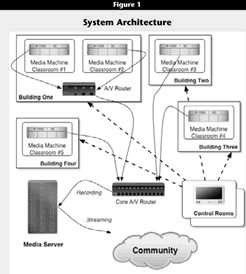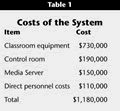Universities increasingly employ information technology to distribute elements of their educational programs beyond campus borders and to find new uses for the intellectual capital they produce. Some faculty, with varying support and success, are moving course materials—and sometimes courses themselves—to the Internet to reach wider audiences. Institutions may record selected presentations—formal lectures by prominent visitors and other special events—to digitize and serve over the Web. For many outside the university, however, the quintessential campus experience is the interaction of a good teacher and bright, eager students in a classroom. Many would welcome the chance to observe this interaction, even if they could not participate directly. Although instructors commonly put reading lists or papers on the Web for wider audiences, such postings do not convey this important, but ephemeral, classroom experience.
Unfortunately, capturing this experience for distribution can be frustrating and costly. Many of us have watched with dissatisfaction video obtained by a single, stationary camera set in the back of a classroom. The teacher passing in and out of the field of view, poor sound quality, and murky renderings of projected slides make most of these videos unappealing or unusable. A production crew to handle the filming—managing the cameras, lighting, and sound recording—can remedy these problems, but at a much greater cost and typically with much more disruption of the class.
In the Center for Technology in Teaching and Learning (CTTL) at Rice University, we have been working to capture classes unobtrusively for distribution beyond the campus. We created classrooms in which we can control cameras, lights, and sound remotely, leaving the normal interaction between teacher and students undisturbed. We developed tools to create digital videos of lectures and discussions with any accompanying computer presentations and demonstrations, videos, music, slides, or other materials. We built a large multimedia server to store the captured classes and to serve them on demand to a wide community of users within and beyond the Rice campus.
Several features of our system have proved particularly important:
- the control facility, remote from the classrooms, from which we control the video capture;
- the design of the multimedia repository; and
- an innovative network architecture to improve video streaming.
We also gained valuable experience from our participation in several projects that used our system.
In a previous EDUCAUSE Quarterly article, we described our network architecture to improve streaming video to an off-campus community.1 Here we discuss the classrooms and related control facility, as well as the multimedia repository. We also discuss the ways in which our system supports academic efforts at Rice.
Capturing the Classroom Experience
The work described here is part of our larger effort to develop an architecture for collecting and organizing multimedia assets and distributing them to various communities associated with Rice—faculty and students, alumni, other educational institutions, and a host of groups and individuals in the Greater Houston area and beyond. Grants from the State of Texas made possible our use of this architecture to support a large electronic community of public school teachers in Houston.2
At the hub of our architecture is a Media Server, which we initially used to disseminate on-demand digital video on best teaching practices to the teacher community. We also used the Media Server to stream professionally produced videos of lectures by prominent visitors to Rice, along with other special events such as conferences. We wanted to add digital video of classes to the assets on the Media Server, but we needed an alternative to professional production, which entails high costs and can be very disruptive in a classroom.
A less disruptive but unsatisfactory way to capture classroom happenings is to station a single camera at the back of a room. Though the capture is simple, the video and audio obtained are generally poor, and there is no facility to switch to focus on changing events during the presentation. Finally, the rendering of any multimedia materials projected is typically very poor.
To facilitate the creation of high-quality digital video of the classroom, we extended technology we had previously developed to help teachers capture aspects of their own teaching—a small, integrated system called the Media Machine that combines computer display (slides, Web pages, simulations, and the like), electronic annotation, and video of the teacher into a single multimedia stream. The system produces digital video in MPEG-2 format, which converts quickly into several streaming formats for distribution from the Media Server.
When used by an experienced teacher, the Media Machine, which we originally installed in a small conference room, significantly reduced setup costs and allowed the production of multimedia "on the fly," with quality approaching what a professional video crew would obtain. The Media Machine fulfilled our desire for high-quality digital video, but to make it widely useful, we needed to integrate it into regular classrooms. More importantly, we needed to free teachers from the obligation to manage the system.
Our first step was to enhance the original Media Machine in the conference room, enabling it to
- control three room cameras and a ceiling-mounted document camera,
- manage room lighting, and
- mix audio streams from several microphones.
We also connected this room to the National Access Grid, enabling Rice to participate in multi-site videoconferences with other universities and research centers through Internet2. The enhanced design exploits several powerful computers and three projectors donated by Intel. Once teachers had tested the new technology, we adapted it for use in four regular classrooms.
In each classroom, we installed four room cameras, a document camera, multiple microphones, new lighting, and videoconferencing units. The last can initiate and receive videoconferencing calls either directly over the Internet or through a local-area/wide-area network (LAN/WAN) gateway on the Rice network. As in the Media Machine, a console lets a presenter direct images from a local computer, a laptop, any of the cameras, or the videoconferencing unit to a large-screen projector. Unlike the Media Machine, the video and audio flow to a control room where several computers simultaneously record and stream the presentation.
Figure 1 shows a schematic of the system architecture.

Figure 1,Click image for larger view.
We created two such control rooms to improve production quality with the least disruption of classes. In a control room, an operator serving as a "director" can remotely manage all the technology in one of the classrooms, switching cameras and angles and controlling lighting, window shades, and sound to record the class activity most effectively. The operator can also manage either a point-to-point or a broadcast videoconference in the classroom.
The linkage between control rooms and classrooms is a complex system of video routers and fiber-optic transmitters. The control room equipment is modest: four monitors that display the video sources from a classroom, a control panel for selecting sources, a computer console for managing the recording of the event, and a joystick control for remotely moving the cameras to follow the activities in the classroom.
By controlling a media-encoding computer, an operator can capture the output from the room cameras, a document camera, or any multimedia source—for example, slides, videotape, television, or a videoconference. The encoding, which is produced in real time, loses some resolution, but the results are significantly better than those obtained by videotaping images projected on a screen. Also, we can automatically synchronize the video stream with audio from the presentation to produce the final product. This is significantly less labor-intensive and costly than editing in the multimedia components after capturing the presentation.
Digital video of classes flows to the Media Server, where it is managed with video assets from a variety of sources, including thousands of hours of multimedia for educators—the Annenberg/CPB collection, substantial portions of the Survivors of the Shoah Visual History Foundation collection of more than 117,000 hours of video archives, video of scientific seminars and presentations by visiting dignitaries, and foreign-language videos.
The Media Server presently encompasses 22 terabytes of disk storage, 7 servers, and robust networking support. Two servers are used for live video encoding, two are used exclusively as servers for live streaming, and three are used for on-demand playback of archived video from the storage array.
The System at Work
We have used the capture system to create digital video archives of a number of educational activities including a graduate, multi-institutional seminar in computational biology; a seminar on informatics with guest speakers from a variety of organizations; a class on astrobiology that is part of a professional development program for school teachers; and collaborations between scientists from academia and business with middle school teachers. In each case, an operator in a remote control room "captured" the classes or seminars and, when needed, also managed videoconferencing to link the classroom to another site.
Participants in these and other educational activities have found the system to be unobtrusive, allowing them to teach as they normally would and yet make their classes available in new ways to new observers. For example, in the multi-institutional seminar, the combination of easy videoconferencing and archived recordings has doubled participation at remote sites. In the informatics seminar, the availability of archived presentations stimulated new approaches to documenting changes in a scientific field.
On average, 540 visitors from Rice and elsewhere access the Media Server each week for archives of these resources. The success of these efforts has prompted suggestions for other applications of the system—linking student teams to corporate mentors, conducting joint classes or projects with foreign sites, archiving review sessions, and offering new approaches to teacher training.
System Costs
The cost of capturing and archiving a class for streaming includes the direct costs to monitor and record the class, provide technical support, and apportion the development costs for the system. Table 1 shows the components of the $1,180,000 we spent to equip the four classrooms, the conference room, and the two control rooms; enhance the Media Server; and manage the implementation. In other environments these costs might be quite different, depending on the available technology and the prior state of the rooms. We pay students $12 to $20 per hour to monitor and capture classes and to do modest processing of the captured proceedings as needed. Technical support for the system runs about $12,500 yearly.

Table 1,Click image for larger view.
The amortization of the initial cost of the system depends on the number of hours captured and the various time frames over which we depreciate the equipment, both of which are uncertain. Once we set the depreciation schedule for the classroom, however, we can easily calculate the expected hourly cost as a function of the number of hours of use. The elements of the system—network, server, displays, cameras—depreciate at different rates, but for illustrative purposes, we assume five-year, straight-line depreciation, or $236,000 per year. Then, if during the school year we capture 150 hours from each classroom at a direct cost of $15 per hour, the average total hourly cost would be $346.3 If we capture an average of 225 hours from each room, the same cost is $230; and at 300 hours, $173. In comparison, the cost per hour for professional capturing and processing exceeds $600. Note also that depreciation is the principal component of the total hourly cost for the system. If we can depreciate the system more slowly, then the hourly cost will go down.
Conclusion
In developing the capture system, we tried to balance the quality of the digital video we produced against the degree of disruption of normal classroom activity. Our early experience indicates that we have succeeded. Faculty, teaching in their accustomed ways, have used the system to disseminate their ideas to new audiences. Their positive experiences have encouraged other faculty to follow suit. Indeed, as we prepared this article, several more teachers were planning to use the new facilities to capture their classes.
